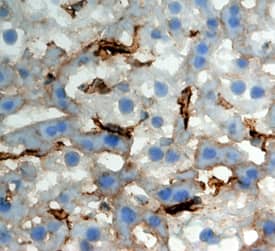Mouse CLEC4F/CLECSF13 Antibody
R&D Systems, part of Bio-Techne | Catalog # MAB2784

Key Product Details
Species Reactivity
Validated:
Cited:
Applications
Validated:
Cited:
Label
Antibody Source
Product Specifications
Immunogen
Ala65-Gly548
Accession # P70194
Specificity
Clonality
Host
Isotype
Scientific Data Images for Mouse CLEC4F/CLECSF13 Antibody
CLEC4F/CLECSF13 in Mouse Liver.
CLEC4F/CLECSF13 was detected in perfusion fixed frozen sections of mouse liver using Rat Anti-Mouse CLEC4F/CLECSF13 Monoclonal Antibody (Catalog # MAB2784) at 5 µg/mL overnight at 4 °C. Tissue was stained using the Anti-Rat HRP-DAB Cell & Tissue Staining Kit (brown; Catalog # CTS017) and counterstained with hematoxylin (blue). Specific staining was localized to Kupffer cells. View our protocol for Chromogenic IHC Staining of Frozen Tissue Sections.Detection of Mouse CLEC4F/CLECSF13 by Immunocytochemistry/Immunofluorescence
CETP protein is not co‐localized with Ly6C protein, but does co‐localize with Clec4f protein. Livers of non‐injected female APOE*3‐Leiden‐CETP mice were assayed for co‐localization of CETP and F4/80 (A), Ly6C (B) and Clec4f (C). Red; F4/80, Ly6C or Clec4f, Green; CETP, Blue; DAPI. Double headed arrows indicate co‐localization, single‐headed arrows indicate no co‐localization. CETP indicates cholesteryl ester transfer protein; Clec4f, C‐type lectin domain family 4; Ly6C, lymphocyte antigen 6 complex locus C. Image collected and cropped by CiteAb from the following publication (https://pubmed.ncbi.nlm.nih.gov/29525783), licensed under a CC-BY license. Not internally tested by R&D Systems.Applications for Mouse CLEC4F/CLECSF13 Antibody
Immunohistochemistry
Sample: Perfusion fixed frozen sections of mouse liver
Western Blot
Sample: Recombinant Mouse CLEC4F/CLECSF13 (Catalog # 2784-CL)
Reviewed Applications
Read 2 reviews rated 4.5 using MAB2784 in the following applications:
Formulation, Preparation, and Storage
Purification
Reconstitution
Formulation
Shipping
Stability & Storage
- 12 months from date of receipt, -20 to -70 °C as supplied.
- 1 month, 2 to 8 °C under sterile conditions after reconstitution.
- 6 months, -20 to -70 °C under sterile conditions after reconstitution.
Background: CLEC4F/CLECSF13
CLEC4F (C-type lectin domain; family 4, member F; also known as the Kupffer cell receptor and fucose receptor) is an 80 kDa, type II transmembrane glycoprotein member of the C-type lectin superfamily (1‑3). Mature mouse CLEC4F consists of a 42 amino acid (aa) cytoplasmic domain, a 27 aa transmembrane segment, and a 479 aa extracellular domain (ECD) that contains an extended stalk region plus one carbohydrate recognition domain (4, 5). Within the ECD, mouse CLEC4F shares 48% and 79% aa sequence identity with human and rat CLEC4F, respectively. The stalk region of CLEC4F is a coiled coil domain that mediates homotrimer formation (6, 7). CLEC4F is expressed on Kupffer cells in the liver, but not on macrophages in other tissues (8). CLEC4F preferentially binds galactose and N‑acetylgalactosamine in a calcium-dependent manner (6, 9, 10). Its activity at neutral, but not at acidic pH, suggests a capacity to internalize and release ligands into the endosomal system (11).
References
- Zelensky, A.N. and J.E. Gready (2005) FEBS J. 272:6179.
- Bilzer, M. et al. (2006) Liver Int. 26:1175.
- Kuiper, J. et al. (1994) Biochem. J. 299:285.
- Accession # P70194.
- Hoyle, G.W. and R.L. Hill (1988) J. Biol. Chem. 263:7487.
- Fadden, A.J. et al. (2003) Glycobiology 13:529.
- Beavil, A.J. et al. (1992) Proc. Natl. Acad. Sci. 89:753.
- Haltiwanger, R.S. et al. (1986) J. Biol. Chem. 261:7433.
- Coombs, P.J. et al. (2006) Glycobiology 16:1C.
- Biessen, E.A.L. et al. (1994) Biochem. J. 299:291.
- Lehrman, M.A. et al. (1986) J. Biol. Chem. 261:7426.
Long Name
Alternate Names
Gene Symbol
UniProt
Additional CLEC4F/CLECSF13 Products
Product Documents for Mouse CLEC4F/CLECSF13 Antibody
Product Specific Notices for Mouse CLEC4F/CLECSF13 Antibody
For research use only

